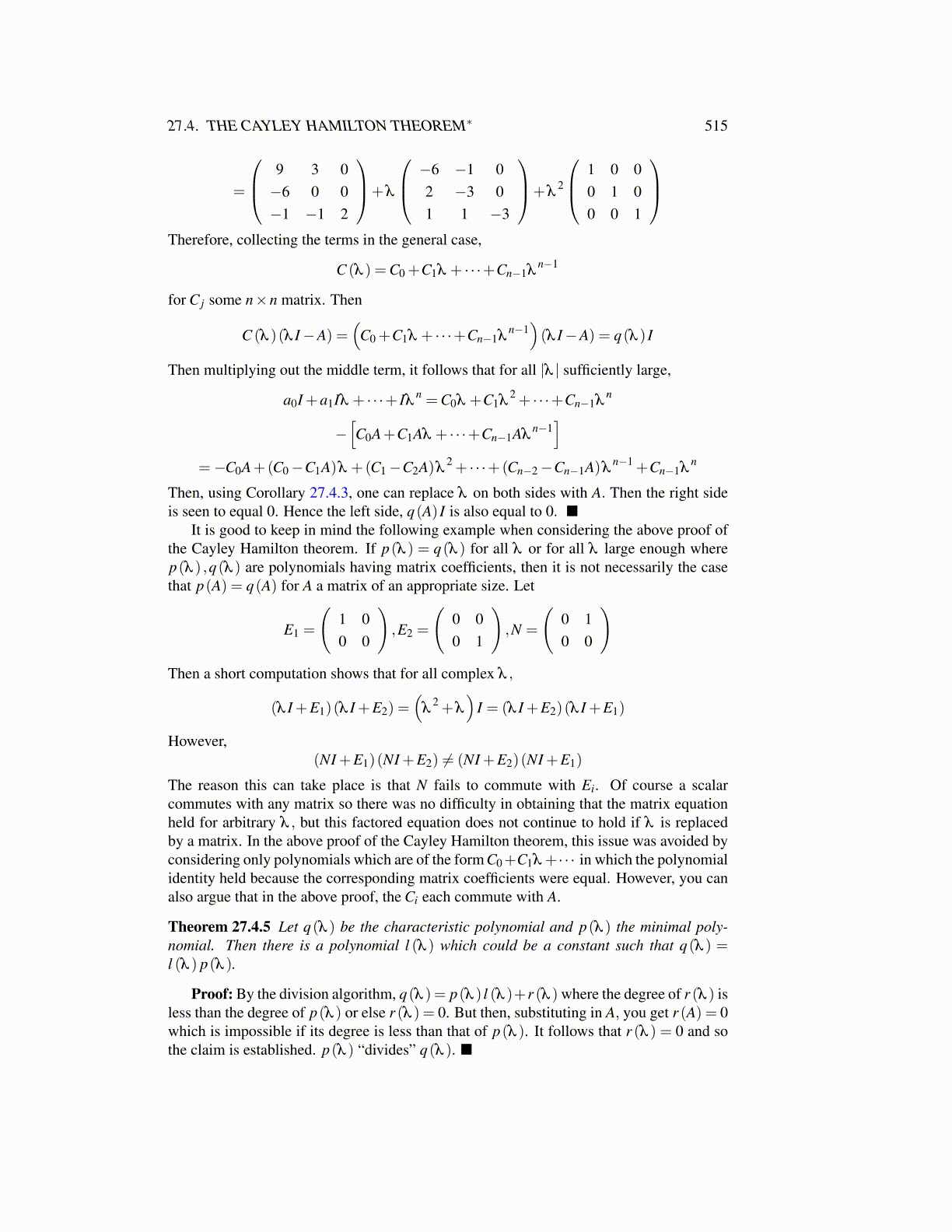
27.4. THE CAYLEY HAMILTON THEOREM∗ 515
=
9 3 0−6 0 0−1 −1 2
+λ
−6 −1 02 −3 01 1 −3
+λ2
1 0 00 1 00 0 1
Therefore, collecting the terms in the general case,
C (λ ) =C0 +C1λ + · · ·+Cn−1λn−1
for C j some n×n matrix. Then
C (λ )(λ I−A) =(
C0 +C1λ + · · ·+Cn−1λn−1)(λ I−A) = q(λ ) I
Then multiplying out the middle term, it follows that for all |λ | sufficiently large,
a0I +a1Iλ + · · ·+ Iλn =C0λ +C1λ
2 + · · ·+Cn−1λn
−[C0A+C1Aλ + · · ·+Cn−1Aλ
n−1]
=−C0A+(C0−C1A)λ +(C1−C2A)λ2 + · · ·+(Cn−2−Cn−1A)λ
n−1 +Cn−1λn
Then, using Corollary 27.4.3, one can replace λ on both sides with A. Then the right sideis seen to equal 0. Hence the left side, q(A) I is also equal to 0. ■
It is good to keep in mind the following example when considering the above proof ofthe Cayley Hamilton theorem. If p(λ ) = q(λ ) for all λ or for all λ large enough wherep(λ ) ,q(λ ) are polynomials having matrix coefficients, then it is not necessarily the casethat p(A) = q(A) for A a matrix of an appropriate size. Let
E1 =
(1 00 0
),E2 =
(0 00 1
),N =
(0 10 0
)Then a short computation shows that for all complex λ ,
(λ I +E1)(λ I +E2) =(
λ2 +λ
)I = (λ I +E2)(λ I +E1)
However,(NI +E1)(NI +E2) ̸= (NI +E2)(NI +E1)
The reason this can take place is that N fails to commute with Ei. Of course a scalarcommutes with any matrix so there was no difficulty in obtaining that the matrix equationheld for arbitrary λ , but this factored equation does not continue to hold if λ is replacedby a matrix. In the above proof of the Cayley Hamilton theorem, this issue was avoided byconsidering only polynomials which are of the form C0+C1λ + · · · in which the polynomialidentity held because the corresponding matrix coefficients were equal. However, you canalso argue that in the above proof, the Ci each commute with A.
Theorem 27.4.5 Let q(λ ) be the characteristic polynomial and p(λ ) the minimal poly-nomial. Then there is a polynomial l (λ ) which could be a constant such that q(λ ) =l (λ ) p(λ ).
Proof: By the division algorithm, q(λ )= p(λ ) l (λ )+r (λ ) where the degree of r (λ ) isless than the degree of p(λ ) or else r (λ ) = 0. But then, substituting in A, you get r (A) = 0which is impossible if its degree is less than that of p(λ ). It follows that r (λ ) = 0 and sothe claim is established. p(λ ) “divides” q(λ ). ■